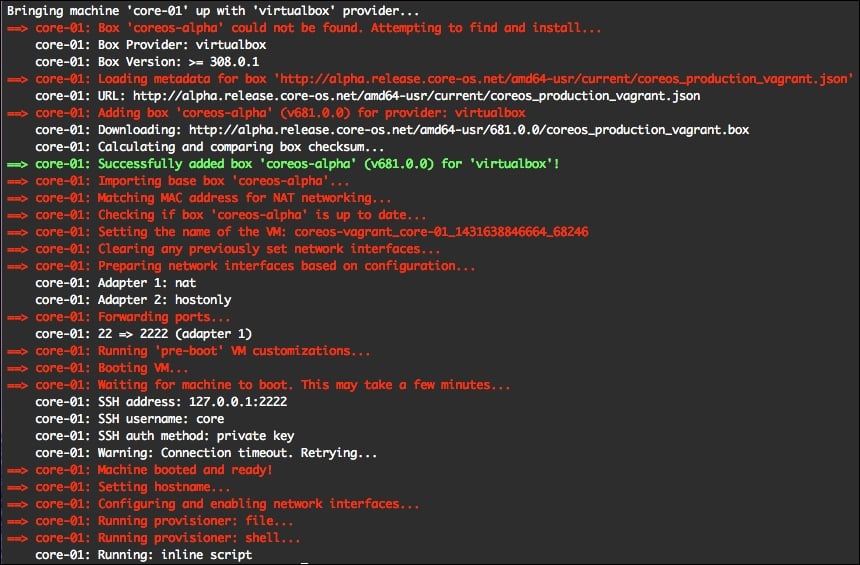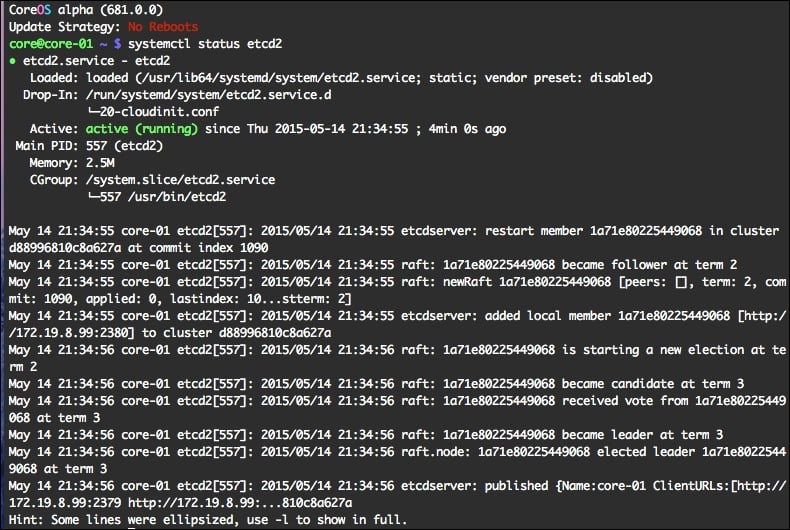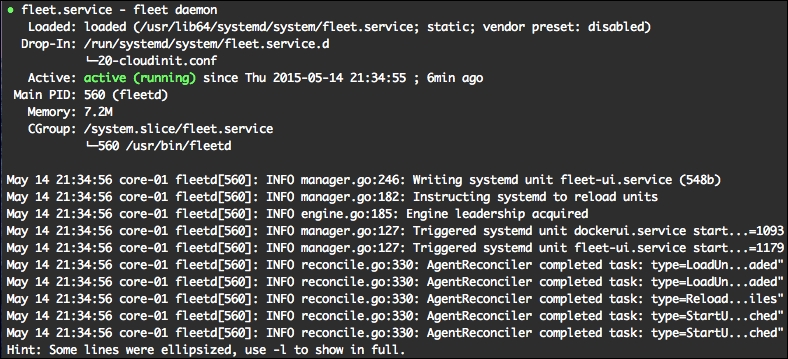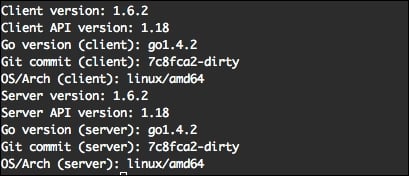CoreOS is often described as Linux for massive server deployments, but it can also run easily as a single host on bare-metal, cloud servers, and as a virtual machine on your computer as well. It is designed to run application containers as docker and rkt, and you will learn about its main features later in this book.
This book is a practical, example-driven guide to help you learn about the essentials of the CoreOS Linux operating system. We assume that you have experience with VirtualBox, Vagrant, Git, Bash shell scripting and the command line (terminal on UNIX-like computers), and you have already installed VirtualBox, Vagrant, and git on your Mac OS X or Linux computer, which will be needed for the first chapters. As for a cloud installation, we will use Google Cloud's Compute Engine instances.
By the end of this book, you will hopefully be familiar with setting up CoreOS on your laptop or desktop, and on the cloud. You will learn how to set up a local computer development machine and a cluster on a local computer and in the cloud. Also, we will cover etcd, systemd, fleet, cluster management, deployment setup, and production clusters.
Also, the last chapter will introduce Google Kubernetes. This is an open source orchestration system for docker and rkt containers and allows to manage them as a single system on on compute clusters.
In this chapter, you will learn how CoreOS works and how to carry out a basic CoreOS installation on your laptop or desktop with the help of VirtualBox and Vagrant.
We will basically cover two topics in this chapter:
An overview of CoreOS
Installing the CoreOS virtual machine
CoreOS is a minimal Linux operation system built to run docker and rkt containers (application containers). By default, it is designed to build powerful and easily manageable server clusters. It provides automatic, very reliable, and stable updates to all machines, which takes away a big maintenance headache from sysadmins. And, by running everything in application containers, such setup allows you to very easily scale servers and applications, replace faulty servers in a fraction of a second, and so on.
CoreOS has no package manager, so everything needs to be installed and used via docker containers. Moreover, it is 40 percent more efficient in RAM usage than an average Linux installation, as shown in this diagram:

CoreOS utilizes an active/passive dual-partition scheme to update itself as a single unit, instead of using a package-by-package method. Its root partition is read-only and changes only when an update is applied. If the update is unsuccessful during reboot time, then it rolls back to the previous boot partition. The following image shows OS updated gets applied to partition B (passive) and after reboot it becomes the active to boot from.

The docker and rkt containers run as applications on CoreOS. Containers can provide very good flexibility for application packaging and can start very quickly—in a matter of milliseconds. The following image shows the simplicity of CoreOS. Bottom part is Linux OS, the second level is etcd/fleet with docker daemon and the top level are running containers on the server.

By default, CoreOS is designed to work in a clustered form, but it also works very well as a single host. It is very easy to control and run application containers across cluster machines with fleet and use the etcd service discovery to connect them as it shown in the following image.

CoreOS can be deployed easily on all major cloud providers, for example, Google Cloud, Amazon Web Services, Digital Ocean, and so on. It runs very well on bare-metal servers as well. Moreover, it can be easily installed on a laptop or desktop with Linux, Mac OS X, or Windows via Vagrant, with VirtualBox or VMware virtual machine support.
This short overview should throw some light on what CoreOS is about and what it can do. Let's now move on to the real stuff and install CoreOS on to our laptop or desktop machine.
To use the CoreOS virtual machine, you need to have VirtualBox, Vagrant, and git installed on your computer.
In the following examples, we will install CoreOS on our local computer, which will serve as a virtual machine on VirtualBox.
Okay, let's get started!
Let's clone this project and get it running.
In your terminal (from now on, we will use just the terminal phrase and use $ to label the terminal prompt), type the following command:
$ git clone https://github.com/coreos/coreos-vagrant/
This will clone from the GitHub repository to the coreos-vagrant folder on your computer.
To start even a single host, we need to provide some config parameters in the cloud-config format via the user data file.
In your terminal, type this:
$ cd coreos-vagrant $ mv user-data.sample user-data
The user data should have content like this (the coreos-vagrant Github repository is constantly changing, so you might see a bit of different content when you clone the repository):
#cloud-config
coreos:
etcd2:
#generate a new token for each unique cluster from https://discovery.etcd.io/new
#discovery: https://discovery.etcd.io/<token>
# multi-region and multi-cloud deployments need to use $public_ipv4
advertise-client-urls: http://$public_ipv4:2379
initial-advertise-peer-urls: http://$private_ipv4:2380
# listen on both the official ports and the legacy ports
# legacy ports can be omitted if your application doesn't depend on them
listen-client-urls: http://0.0.0.0:2379,http://0.0.0.0:4001
listen-peer-urls: http://$private_ipv4:2380,http://$private_ipv4:7001
fleet:
public-ip: $public_ipv4
flannel:
interface: $public_ipv4
units:
- name: etcd2.service
command: start
- name: fleet.service
command: start
- name: docker-tcp.socket
command: start
enable: true
content: |
[Unit]
Description=Docker Socket for the API
[Socket]
ListenStream=2375
Service=docker.service
BindIPv6Only=both
[Install]
WantedBy=sockets.target Replace the text between the etcd2: and fleet: lines to look this:
etcd2:
name: core-01
initial-advertise-peer-urls: http://$private_ipv4:2380
listen-peer-urls: http://$private_ipv4:2380,http://$private_ipv4:7001
initial-cluster-token: core-01_etcd
initial-cluster: core-01=http://$private_ipv4:2380
initial-cluster-state: new
advertise-client-urls: http://$public_ipv4:2379,http://$public_ipv4:4001
listen-client-urls: http://0.0.0.0:2379,http://0.0.0.0:4001
fleet:Note
You can also download the latest user-data file from https://github.com/rimusz/coreos-essentials-book/blob/master/Chapter1/user-data.
This should be enough to bootstrap a single-host CoreOS VM with etcd, fleet, and docker running there.
We will cover cloud-config, etcd and fleet in more detail in later chapters.
It's now time to boot our CoreOS VM and log in to its console using ssh.
Let's boot our first CoreOS VM host. To do so, using the terminal, type the following command:
$ vagrant up
This will trigger vagrant to download the latest CoreOS alpha (this is the default channel set in the config.rb file, and it can easily be changed to beta, or stable) channel image and the lunch VM instance.
You should see something like this as the output in your terminal:

CoreOS VM has booted up, so let's open the ssh connection to our new VM using the following command:
$ vagrant ssh
It should show something like this:
CoreOS alpha (some version) core@core-01 ~ $
Tip
Downloading the example code
You can download the example code files from your account at http://www.packtpub.com for all the Packt Publishing books you have purchased. If you purchased this book elsewhere, you can visit http://www.packtpub.com/support and register to have the files e-mailed directly to you.
Perfect! Let's verify that etcd, fleet, and docker are running there. Here are the commands required and the corresponding screenshots of the output:
$ systemctl status etcd2

To check the status of fleet, type this:
$ systemctl status fleet

To check the status of docker, type the following command:
$ docker version

Lovely! Everything looks fine. Thus, we've got our first CoreOS VM up and running in VirtualBox.
In this chapter, we saw what CoreOS is and how it is installed. We covered a simple CoreOS installation on a local computer with the help of Vagrant and VirtualBox, and checked whether etcd, fleet, and docker are running there.
You will continue to explore and learn about all CoreOS services in more detail in the upcoming chapters.





















